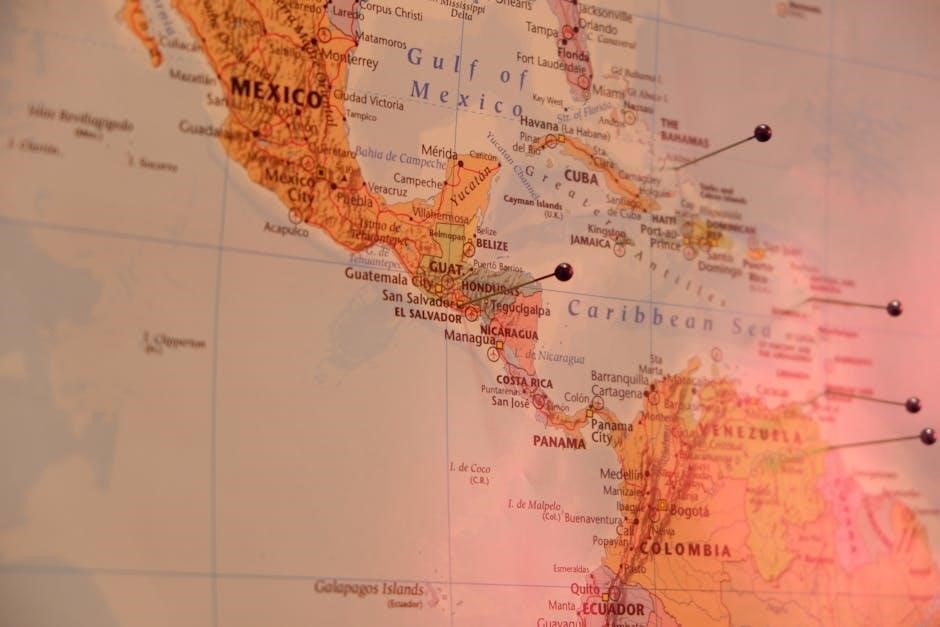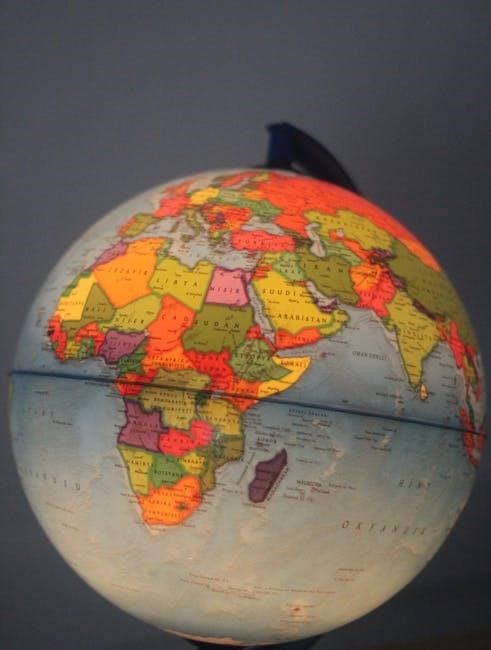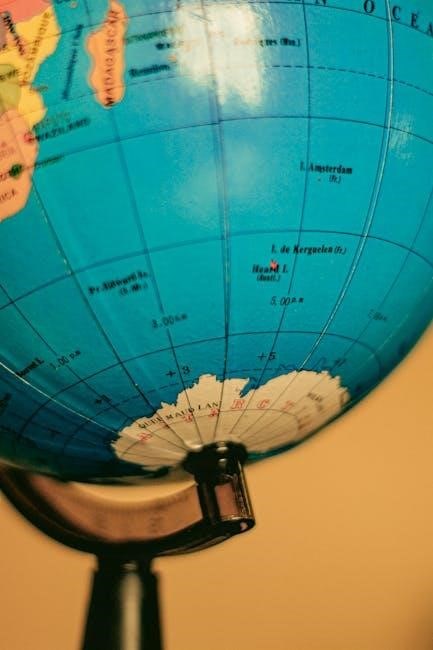A World Map with Latitude and Longitude is a key tool for navigation and education, providing precise coordinates. It’s available as a PDF for easy use in understanding global geography and spatial relationships, ideal for students and researchers.
1.1 What Are Latitude and Longitude?
Latitude and longitude are angular measurements that define the position of any location on Earth. Latitude is measured in degrees, minutes, and seconds north or south of the equator, ranging from 0° at the equator to 90° at the poles. Longitude measures east or west of the prime meridian, ranging from 0° to 180°. Together, they form a grid system, with latitude lines running horizontally and longitude lines vertically, enabling precise location identification on a world map.
1.2 Importance of Latitude and Longitude in Mapping
Latitude and longitude are fundamental for creating accurate world maps. They enable precise location identification, navigation, and spatial analysis. By dividing the Earth into a grid system, these coordinates help determine time zones, track climate patterns, and facilitate global communication. Their importance lies in providing a universal reference system, essential for aviation, maritime navigation, and geographic research. Without latitude and longitude, modern mapping and GPS technologies would be impossible, making them indispensable tools for understanding and exploring our planet.
1.3 The Grid System of the Earth
The Earth’s grid system comprises latitude and longitude lines, forming a global network. Latitude lines run horizontally, measuring 0° at the equator to 90° at the poles, while longitude lines run vertically, measuring 0° at the prime meridian to 180° east and west. This grid system divides the planet into precise segments, enabling accurate location identification and spatial analysis. It is visually represented on world maps, allowing users to pinpoint locations and understand global geography effectively, making it a cornerstone of cartography and navigation.

Understanding the Basics of Latitude and Longitude
Latitude and longitude form Earth’s grid system. Latitude lines run horizontally, dividing the globe into northern and southern hemispheres. Longitude lines run vertically, circling the globe, creating a system to pinpoint locations accurately.
2.1 Definition of Latitude
Latitude refers to the angular distance of a place north or south of the Earth’s equator. Measured in degrees, it ranges from 0° at the equator to 90° at the poles. These horizontal lines, or parallels, help determine a location’s position and climate, with higher latitudes experiencing more extreme seasons. This measurement is crucial for navigation and understanding global geography, as seen on a World Map with Latitude and Longitude.
2.2 Definition of Longitude
Longitude measures the angular distance of a place east or west of the prime meridian. It ranges from 0° to 180° east or west. These vertical lines, or meridians, converge at the poles. Longitude, along with latitude, helps pinpoint exact locations on Earth. It is essential for navigation and understanding time zones, as each degree of longitude corresponds to a four-minute time difference. This system is clearly marked on World Maps with Latitude and Longitude, aiding in precise location identification and global mapping.
2.3 How Latitude and Longitude Work Together
Latitude and longitude form a grid system that identifies precise locations on Earth. Latitude measures north-south position, while longitude measures east-west position. Together, they create a unique coordinate for any point, enabling accurate mapping. The combination of these angles allows users to determine distances, navigate globally, and understand spatial relationships. This system is vital for applications like GPS, aviation, and cartography, making it indispensable for modern navigation and geographic studies. The World Map with Latitude and Longitude visually represents this grid, simplifying global location identification.

The World Map with Latitude and Longitude
A World Map with Latitude and Longitude visually displays Earth’s grid system, helping users pinpoint locations and understand global geography. It’s available as a PDF for easy download and printing, making it a handy tool for education, navigation, and research.
3.1 Key Features of the Map
The World Map with Latitude and Longitude features a grid system with parallel lines of latitude and meridians of longitude. It includes significant geographical coordinates, time zones, and country boundaries. The map is available in high-resolution PDF format, making it ideal for printing and educational purposes. Users can easily navigate and locate specific countries and cities using the precise coordinate system. The map also highlights major continents, oceans, and hemispheres, providing a comprehensive view of the Earth’s geography.
3.2 How to Read the Map
To read the World Map with Latitude and Longitude, identify the grid system where horizontal lines represent latitude and vertical lines represent longitude. Each intersection of lines provides precise coordinates. Users can locate countries, cities, and geographical features by aligning the grid with the scale. The PDF format allows zooming for detailed views, making it easier to pinpoint locations. This system enables accurate navigation and understanding of global spatial relationships, essential for education and research purposes.
3.3 Significant Lines of Latitude and Longitude
The World Map with Latitude and Longitude highlights key reference lines. The Equator (0° latitude) divides the Northern and Southern Hemispheres, while the Prime Meridian (0° longitude) separates the Eastern and Western Hemispheres. The Tropic of Cancer (23.5°N) and Tropic of Capricorn (23.5°S) mark the tropics. The Arctic Circle (66.5°N) and Antarctic Circle (66.5°S) enclose the polar regions. These lines provide essential orientation and help define global climate zones and geographical regions.
Uses of a World Map with Latitude and Longitude
A World Map with Latitude and Longitude aids in navigation, education, and time zone determination. It helps locate places, understand spatial relationships, and study global geography effectively.
4.1 Navigation and Exploration
A World Map with Latitude and Longitude is indispensable for navigation and exploration. It helps determine precise locations, plot points, and identify time zones. By using these coordinates, explorers and travelers can pinpoint destinations accurately. The map is essential for aviation and maritime navigation, guiding pilots and sailors worldwide. Additionally, it aids in scientific research and surveying, ensuring accurate global positioning. This tool is vital for adventurers and professionals alike, facilitating precise movement and discovery across the globe.
4.2 Educational Purposes
A World Map with Latitude and Longitude is a valuable educational tool for teaching geography and spatial awareness. It helps students and educators understand global coordinates, enabling them to locate countries, cities, and natural features accurately. The PDF format makes it easy to download and print for classroom use or homework assignments. This map is ideal for improving map-reading skills and fostering a deeper understanding of the Earth’s layout. It serves as a practical resource for both teachers and students, promoting interactive learning and geographic research.
4.3 Time Zone Determination
A World Map with Latitude and Longitude aids in determining time zones by showing how lines of longitude divide the Earth. Each zone corresponds to specific longitudinal ranges, allowing users to identify local times globally. This feature is particularly useful for international communication and travel planning. The PDF format ensures clarity and convenience, making it an essential resource for anyone needing to understand global time differences and their geographical basis. It simplifies the complexity of time zones into a visual, accessible format.
How to Use the World Map with Latitude and Longitude
A World Map with Latitude and Longitude helps locate specific places using their coordinates. It’s a vital tool for navigation and education, available as a PDF for easy use.
5.1 Finding Specific Locations
Using a World Map with Latitude and Longitude, users can pinpoint specific locations by identifying their coordinates. The latitude (horizontal lines) and longitude (vertical lines) create a grid system, allowing precise location identification. For example, a location at 40°N latitude and 75°E longitude can be found by intersecting these lines. This method is essential for navigation, education, and research. The PDF format makes it easy to download and print, ensuring accessibility for both practical and educational purposes. It’s a versatile tool for understanding global geography and spatial relationships.
5.2 Determining Time Zones
A World Map with Latitude and Longitude helps determine time zones by using longitude lines. Each 15° of longitude represents approximately 1 hour of time difference. The prime meridian (0°) serves as the starting point, with time zones increasing east or west. By identifying a location’s longitude, users can estimate its time zone. This feature is particularly useful for global communication and travel planning. The PDF format allows easy visualization of these lines, making time zone calculation straightforward and accurate.
5.3 Understanding Spatial Relationships
A World Map with Latitude and Longitude enhances the understanding of spatial relationships by visually representing the Earth’s grid system. The latitude and longitude lines allow users to measure distances and connections between regions. This tool helps identify how countries and oceans are positioned relative to each other. The PDF format enables easy zooming and printing, making it ideal for studying global geography. By analyzing these coordinates, users can better comprehend the size and placement of continents, oceans, and landforms, fostering a deeper understanding of the world’s layout.

World Map with Latitude and Longitude in PDF Format
A World Map with Latitude and Longitude in PDF format is a versatile tool for navigation, education, and research. It offers a clear grid system for precise location identification and is easily downloadable and printable, making it ideal for various purposes.
6.1 Benefits of PDF Maps
PDF maps with latitude and longitude offer high-resolution printing, ensuring clarity for detailed analysis. They are easily downloadable and compatible with all devices, making them accessible for education, navigation, and research. The ability to zoom in without losing quality is a significant advantage, allowing precise location identification. Additionally, PDF maps are often free, making them a cost-effective resource for students, teachers, and professionals. Their versatility in both digital and printed formats enhances their utility for various applications, from classroom use to fieldwork.
6.2 How to Download and Print the Map
Downloading and printing a World Map with Latitude and Longitude in PDF is straightforward. Visit reliable websites offering free or paid maps, select your preferred size (e.g., A4 or A5), and download the file. Open the PDF using a viewer like Adobe Acrobat, then print it on standard paper. Many maps are free, while some collections require payment via PayPal or credit cards. Ensure your printer settings match the document size for optimal results. This process ensures high-quality maps for education, navigation, or personal use.
6.3 High-Resolution and Printable Maps
High-resolution World Maps with Latitude and Longitude are ideal for clarity and precision. These PDF maps are designed for printing, offering detailed views of global geography. Available in formats like A4 and A5, they ensure crisp visuals when printed. Many maps are free to download, while others may require a small fee. They are perfect for education, research, or navigation, providing a clear grid of latitude and longitude lines to pinpoint locations accurately. Their high quality makes them suitable for both personal and professional use.

Types of Projections for World Maps
World maps use various projections like Mercator and Miller to represent Earth’s surface. These projections aim to provide an accurate representation of global geography and spatial relationships, enhancing map readability and usability.
7.1 Mercator Projection
The Mercator Projection, developed by Gerardus Mercator in 1569, is a cylindrical map projection widely used for navigation; It preserves angles, making it ideal for maritime and aviation purposes. However, it distorts land sizes, especially near the poles, leading to inaccuracies in area representation. Despite this, the Mercator Projection remains popular for its simplicity and practicality in charting courses, aligning with true north, and maintaining directional accuracy, making it a valuable tool for world maps with latitude and longitude.
7.2 Miller Projection
The Miller Projection, introduced by Osborn Mair in 1942, is a modified cylindrical projection. It balances shape and size distortions, offering a more accurate representation of the Earth compared to the Mercator Projection. The Miller Projection is particularly accurate near the equator and is commonly used in educational and thematic maps. It is often utilized in world maps with latitude and longitude for its ability to present a balanced view of global geography, making it a preferred choice for educational and research purposes.
7.3 Other Common Projections
Beyond Mercator and Miller, other projections like Gall-Peters, Robinson, and Winkel Tripel are widely used. The Gall-Peters projection is favored for its accuracy in representing landmass sizes, while the Robinson projection balances shape and area. The Winkel Tripel minimizes distortion by combining elements of other projections. These alternatives are often used in world maps with latitude and longitude to provide diverse perspectives, catering to different needs such as education, thematic mapping, and visual appeal.
Sources for World Maps with Latitude and Longitude
Reliable websites offer free world maps with latitude and longitude in PDF format. Sources include educational platforms, GIS tools, and downloadable high-resolution maps for education and navigation purposes.
8.1 Reliable Websites for Download
Several trusted websites offer free world maps with latitude and longitude in PDF format. Platforms like educational websites and map repositories provide high-resolution, downloadable maps. These sites often feature detailed grids, country boundaries, and clear latitude and longitude markings. Users can easily print or save these maps for educational, navigational, or research purposes. Many sites also include guides on how to interpret the coordinates, making them ideal for students and professionals alike. Ensure to choose reputable sources for accurate and up-to-date cartographic data.
8.2 Educational Resources
Educational resources, such as PDF world maps with latitude and longitude, are widely available for teaching and learning. These tools are designed to help students and educators understand global geography. Many websites offer printable maps with clear grids, ideal for classroom use. Teachers can use these maps to create engaging lessons on latitude and longitude. Additionally, interactive maps and worksheets are provided to enhance learning experiences. These resources are perfect for teaching the basics of cartography and spatial awareness, making complex concepts accessible to learners of all ages.
8.3 Geographic Information Systems (GIS)
Geographic Information Systems (GIS) utilize latitude and longitude to create detailed spatial analyses. These systems integrate data with maps, enabling advanced applications like urban planning and environmental studies. GIS tools allow users to edit and analyze PDF world maps, overlaying data for precise location-based insights. By leveraging latitude and longitude, GIS provides accurate spatial referencing, making it invaluable for professionals and researchers in various fields. This technology enhances mapping capabilities, offering a comprehensive understanding of global geography and data distribution.
Applications of Latitude and Longitude in Real Life
Latitude and longitude are crucial for aviation, maritime navigation, and emergency services. They enable precise location identification, aiding in GPS technology, search and rescue operations, and geographic research.
9.1 Aviation and Maritime Navigation
In aviation and maritime navigation, latitude and longitude are essential for plotting precise routes. Pilots and sailors rely on these coordinates to determine positions, ensuring safe and efficient travel. GPS systems use these grids to guide aircraft and ships, reducing errors and enhancing navigation accuracy. This precise location identification is critical for avoiding collisions and adhering to designated pathways. The use of latitude and longitude in these industries underscores their importance in modern transportation and global trade, enabling seamless movement across the globe.
9.2 Geographic Research and Surveying
Geographic research and surveying heavily depend on latitude and longitude for accurate data collection. Researchers use these coordinates to identify study areas, track environmental changes, and conduct spatial analysis. GIS technologies leverage this grid system to create detailed maps, aiding in urban planning and natural resource management. The precision of latitude and longitude ensures reliable data, making them indispensable tools for scientists and surveyors in understanding and mapping Earth’s features effectively and efficiently.
9.3 Emergency Services and GPS
Emergency services rely on latitude and longitude for precise location identification. GPS systems use these coordinates to navigate and track locations in real-time, ensuring rapid response during emergencies. By integrating latitude and longitude into GPS devices, emergency services can quickly pinpoint caller locations, optimizing rescue operations. High-resolution PDF maps with these grids further enhance situational awareness, aiding in strategic planning and resource allocation during critical situations.
World Maps with Latitude and Longitude are essential tools for navigation, education, and understanding global geography. Their availability in PDF format makes them accessible and practical for various purposes, from schooling to professional use, ensuring precise location identification and spatial awareness.
10.1 Summary of Key Points
World Maps with Latitude and Longitude are vital tools for understanding global geography. They provide precise location identification using coordinate systems, aiding in navigation, education, and research. The PDF format ensures easy accessibility, printing, and sharing, making them ideal for classroom use and professional applications. These maps highlight the Earth’s grid system, enabling users to determine time zones, spatial relationships, and significant geographic features. Their availability in high-resolution PDF formats enhances usability for diverse purposes, from academic studies to real-world navigation and exploration.
10.2 Future of Mapping Technologies
The future of mapping technologies is poised to revolutionize how we interact with World Maps with Latitude and Longitude. Advances in GIS, AI, and real-time data integration will enhance precision and accessibility. Interactive and dynamic maps will become more prevalent, offering customizable layers and instant updates. High-resolution PDF maps will remain essential for offline use, while digital platforms will dominate online applications. These innovations will make mapping more user-friendly and adaptable, ensuring that latitude and longitude remain central to global navigation and understanding.
10.3 Encouragement to Explore and Learn More
Embrace curiosity and explore the fascinating world of geography with World Maps with Latitude and Longitude. These tools offer a gateway to understanding global connections and spatial relationships. By using PDF maps and interactive resources, you can deepen your knowledge of Earth’s layout. Encourage others to join you in this journey of discovery, fostering a greater appreciation for the world’s diversity and complexity. Start your adventure today and unlock the endless possibilities of learning with latitude and longitude as your guide!